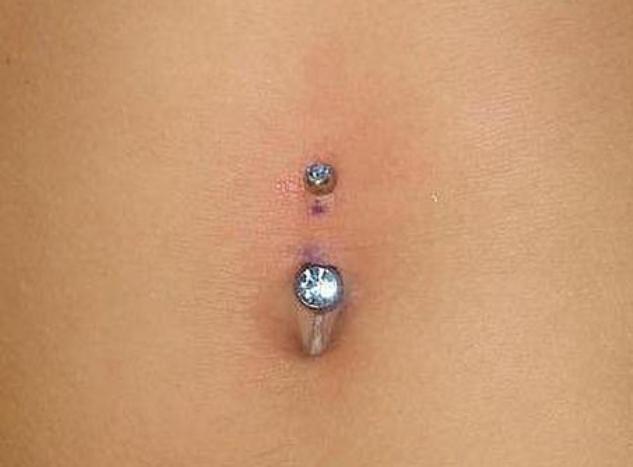The location of the navel, being in a dark and damp place, is commonly considered as the part of your body where infections occur. If your navel is very deep, there are more chances to get infection there. It’s one among those body parts which are expected to more sweet. Additionally there might various substances to be deposited if you have navel piercing. The infected navel piercing rate is fairly high among all other piercing infections.
Belly button piercing, also known as navel piercing is beautiful, but unfortunately it requires good piercing techniques, high standards of hygiene and best aftercare for effective healing. Navel piercing is the next most risky piercing after the eye. It is so because the navel piercing hole can be a gateway for infections reaching your abdominal cavities. It can be risky because needles used to pierce the skin can spread infections because the ring will always touch your clothing. Besides all this, there are inherent risks of injuries, belly button piercing scars, piercing rejection, stretch from weight gain or pregnancy, among other minor discomforts.
Formation of a bump on your pierced belly button is a common sign of an infection. This may take place after the few initial weeks of the piercing. The bump is likely to develop into a scar if not urgently attended to. There are various ways on how to clean an infected belly button piercing can help in getting rid of the bump. But sometimes, seeking medical attention may be the only option if the infection is not responding to aftercare treatments. Bump can be without infection and bump with infection. Granulomas is a bump that forms as a result of overgrown body tissue and may not be due to an infection. When the bump resembles a pimple and contains a discharge, it is defiantly an infection.

Infected Belly Button Piercing Symptoms, Treatment
You are planning to have Belly Button piercing but want to be fully aware of risks associated with it, then keep reading, you will find all what you should know in this regard.
Belly Button’s Infection Causes
Before we look the symptoms and the way such infection could be treated, it’s important to know, what kind of factors might act as causes for such infections.
- The most common causes of pierced navel infections include bacteria and allergic reactions.
- Fungi, yeast, and other pathogenic microorganism can also cause infections.
- You may give favorable environment to such pathogens by not cleaning your piercing regularly, touching it with dirty hands, poor personal hygiene, injuries, unsterilized piercing equipment or using piercing jewelry that may cause allergies.
- It takes usually between 9 months to a year to heal your piercing area completely. This healing time, especially the first few weeks are critical, to avoid getting infection.
- Follow the aftercare routine religiously and you will not have any of the problems, risks and dangers associated with this piercing type.
Belly Button’s infection Signs
Belly button infections are quite obvious and can be noticed easily. If you observe that:
- the piercing becomes red and tender, and remain so for longer than first two weeks, it may be a sign of belly button piercing infection.
- your belly button becomes swollen for a longer time than the required time.
- green or yellow discharge from pierced area. Discharge is normal after a week from the session but extreme amount of discharge may be a sign of an infection.
- formation of excessive crusts on the wound or bump.
- prolonged healing process can also be a symptom of an infection.
- constant soreness and high skin sensitivity that can be irritated by the touch of a shirt or blouse.
- the navel piercing ring or bars will hang more loosely compared to when it got placed.
- constant pain especially when touched by anything.
- inflammation and irritation due to over sensitivity.
Treatment for Infected Belly Button Piercing
If you have one of the above given symptoms but on low extant then try one of the following treatments. If your infection is not responding then consult doctor immediately. The medical professional will prescribe antibiotic cream or tablets. Apply the cream and use antibiotics as prescribed.
- Sea salt soak is considered the best way to get rid of belly button piercing bump at home. Take a little amount of sea salt in a paper cup and fill it with hot water. Soak a clean cotton ball into the sea salt water solution and squeeze out most of the excess water. Gently press the cotton ball to your infected belly button piercing. Repeat for about 4 to 6 times using a fresh cotton ball soaked in hot sea salt water. Now take some clean warm water and splash on your belly button to wash off salt residue and dry using clean paper towel.
- Tea Tree oil is another thing that is used to prevent the piercing infections. As undiluted tea tree oil can burn your skin so take some tree oil and mix it with any good skin care oil and dub on the piercing using a cotton bud. Applying twice a day for effective outcome. a reason as to why you should dilute using any skin friendly oil.
- Applying warm compresses can also be good to avoid infections. Using a clean pierce of cloth, apply warm compresses on the infected area. This will ensure proper drainage and fasten infected navel piercing healing process and it will increase blood flow to the navel.
 Health & Care Information
Health & Care Information 

